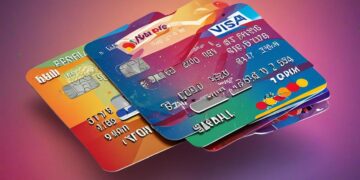Credit cards that help build credit for young people in the USA

The Importance of Building a Strong Credit Portfolio
In today’s financial landscape, establishing a solid credit history is crucial for young individuals. Without a well-maintained credit score, securing loans for major purchases such as homes or cars can become a daunting challenge. One of the most effective tools for developing a good credit profile is a credit card specifically designed to aid in building credit.
Understanding how credit cards function and the responsibilities that come with them can empower young adults to make informed financial decisions. Here are some key benefits:
- Establishing Credit History: Responsible use of a credit card is one of the simplest ways for young people to create a positive credit history. Simply having a credit card and making purchases can contribute to their credit file, which lenders review when assessing credit applications.
- Improving Credit Scores: Timely payments are crucial; paying the bill on or before the due date helps avoid late fees and contributes positively to credit scores. Additionally, maintaining low credit utilization rates—ideally around 30% or less of the card’s limit—shows financial responsibility and can significantly boost a person’s credit score over time.
- Financial Education: Managing a credit card involves more than just spending; it requires budgeting and tracking expenses. Young adults learn the importance of managing their cash flow, understanding interest rates, and making payments. This experience translates into critical financial literacy that will serve them well throughout their lives.
Furthermore, many credit cards tailored for novice users come with additional incentives. For instance, consider the following perks:
- Reward Points: Certain credit cards allow users to earn points for each dollar spent, which can later be redeemed for travel, merchandise, or statement credits. This can be particularly appealing for those who enjoy dining out or shopping creatively.
- No Annual Fees: Many introductory credit cards come without annual fees, which helps reduce initial costs for first-time users. This feature encourages responsible financial habits without burdening users with upfront expenses.
- Cash Back: Many credit cards offer a percentage of cash back on purchases. This means that every time young adults spend money on necessary items like groceries or gas, they earn a little back—essentially turning their spending into a minor profit.
As young people embark on their financial journeys, selecting the right credit card can make a significant difference. By understanding both the responsibilities and benefits associated with credit cards, they not only enhance their creditworthiness, but also build a solid foundation for future financial freedom. Therefore, investing time in researching and comparing the wide array of options available in the market can unlock doors to favorable loan terms, insurance rates, and beyond.
SEE ALSO: Click here to read another article
Finding the Right Credit Card for Young Adults
As young adults begin their journey into financial independence, selecting an appropriate credit card is a pivotal step in building a strong credit profile. The options available in the market can be overwhelming, but understanding the key features and benefits of different credit cards can make the decision easier and more rewarding.
When choosing a credit card, young individuals should look for specific attributes that align with their financial goals. Here are some essential factors to consider:
- Introductory Offers: Many credit cards provide enticing introductory offers, such as bonus points or cashback for spending a certain amount within the first few months. This can be a spectacular way to kickstart a new account and start building credit while also reaping rewards right off the bat.
- Credit Limits: For those just starting out, credit limits may be on the lower side. It’s wise to choose a card with a reasonable credit limit that encourages responsible spending without risking overspending. This enables young people to utilize their credit without incurring significant debt, a balancing act crucial to maintaining a healthy credit profile.
- Secured Credit Cards: A secured credit card is an excellent option for first-time credit users. These cards require a security deposit, which acts as collateral and typically serves as the user’s credit limit. By using a secured card responsibly, young adults can gradually build their credit score while minimizing their risk of going into debt.
- Rewards Programs: Several credit cards offer reward programs geared toward young spenders. Rewards can include cash back on everyday purchases, points redeemable for travel, or discounts at popular retailers. For young people who are likely to make regular purchases, these rewards can provide an extra incentive to use their credit card wisely.
In addition to selecting the right card, young adults must also be aware of the **importance of ongoing management** of their credit. This involves not only making timely payments but also understanding and monitoring their credit utilization ratio—the amount of credit used compared to the total limit. Generally, maintaining a utilization rate below 30% is ideal, as it reflects sound financial habits to lenders.
Moreover, young individuals should take advantage of technology to manage their finances. Many credit card issuers offer mobile apps that provide real-time updates, making it easier to track spending and manage bills. Utilizing these tools can lead to better financial oversight and help young users stay within their budget, preventing month-end surprises and potential credit score damage.
Awareness of fees that may come with credit cards is equally essential. While some cards charge annual fees, several options exist with no fees, especially for newcomers looking to establish their credit profile. Understanding these details empowers young adults to make better choices and maximize their credit-building potential.
By carefully weighing the options available and sticking to fundamental credit management practices, young people can set themselves up for financial success. The right credit card is not just a means to spend; it’s a stepping stone toward building a robust credit history that will serve them well in the years to come.
CHECK OUT: Click here to explore more
Understanding the Impact of Credit Cards on Financial Futures
For young people stepping into adulthood, grasping the nuances of credit cards is vital not just for immediate benefits, but for long-term financial health. As they build their credit profiles, the decisions made with their first credit card can reverberate into significant opportunities down the line—like securing loans for a car or even a mortgage.
After accessing the right credit card, young adults should focus on two critical components of credit management: payment history and credit utilization. These factors significantly influence credit scores, which typically range from 300 to 850. Payment history accounts for about 35% of the total score. Making timely payments on every outstanding balance not only avoids costly late fees but also demonstrates reliability to lenders.
In conjunction with payment history, understanding credit utilization—defined as the ratio of current credit balances to credit limits—is crucial. A credit utilization rate of under 30% is ideal. For instance, if a credit limit is $1,000, it’s best to maintain a balance below $300. Young adults should adopt strategies such as planning purchases around payment cycles, making payments multiple times a month, or keeping track of spending via budgeting tools.
The Role of Credit Building Resources
Beyond personal accountability, young adults should leverage the plethora of resources available for credit education. Numerous credit card issuers provide educational materials, articles, and interactive tools aimed at helping users enhance their financial literacy. Engaging with these resources can demystify terms like APR (Annual Percentage Rate) and credit limits, empowering young individuals to make informed decisions about their credit usage.
Additionally, young adults are advised to check their credit reports regularly. In the U.S., consumers are entitled to one free credit report from each of the three major credit bureaus—Equifax, Experian, and TransUnion—annually. Monitoring credit reports can alert users to errors, which, if corrected, can boost their credit scores. Furthermore, understanding the contents of a credit report can reveal patterns in one’s financial behavior that may need adjustments.
Exploring Alternatives: FinTech and Student-Friendly Cards
The emergence of FinTech companies has revolutionized the financial landscape, offering innovative options designed for young consumers. Many of these alternatives offer features like instant approval processes, lower fees, and enhanced rewards tailored to student lifestyles. For example, some cards even offer discounts on streaming services or educational tools, making them more enticing for younger users.
Moreover, several credit unions and local banks provide student-friendly credit cards with lower interest rates and favorable terms. These institutions often work closely with young consumers to educate them about wise credit usage, thereby fostering responsible financial habits from an early age. Additionally, some banks offer programs that allow young users to link their savings accounts to their credit cards, promoting saving while spending.
In a rapidly evolving credit landscape, staying informed is essential. By actively seeking out information about credit card options and engaging in ongoing education, young adults can unlock a suite of financial tools that extend beyond immediate spending power, securing their positions as future-oriented financial stewards.
CHECK OUT: Click here to explore more
Final Thoughts on Credit Building for Young Adults
In summary, the path to establishing a strong credit history for young people in the USA begins with choosing the right credit card that aligns with their financial goals and lifestyle. By focusing on critical aspects such as payment history and credit utilization, these young adults can lay the groundwork for a robust credit score, which can open doors to significant financial opportunities in the future. Engaging in financial literacy through educational resources and regular monitoring of credit reports further empowers them to make informed decisions and navigate the complex world of credit.
As technology continues to reshape financial services, FinTech innovations present exciting alternatives for building credit, catering specifically to the unique needs of the younger demographic. Student-friendly credit cards and credit union offerings provide accessible ways to cultivate healthy financial habits, allowing millennials and Generation Z to approach their financial futures with confidence.
Ultimately, the responsibility lies with young consumers to remain disciplined and informed. By leveraging the available tools and resources, they can turn credit cards into vehicles for financial empowerment rather than pitfalls of debt. Encouraging a culture of smart credit usage today ensures a safer financial landscape tomorrow. As they embark on this journey, the insights gained now will serve as a foundation for financial stability and success well into the future.






